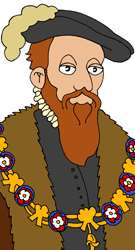|
Kids Home
London
Royalty
Romans
Early
Kingdoms
Berkshire
Teacher's Page
Mail David


|
|

Edward Seymour, Duke of Somerset

|
- Edward was the brother of Queen
Jane Seymour. When in the country, he lived at Wolf Hall near Burbage
in Wiltshire. The two had grown up there.
- Edward became an important man
at the Royal Court when his sister became queen. After she died, he
looked after his nephew, Prince Edward. He was made Earl of Hertford.
- When Edward became king, he was
too young to rule. So his Uncle Edward ran the country for him during the
1540s. He was
called the 'Lord Protector'. Edward also made him the Duke of Somerset.
- The Duke was a Protestant. He
had the King educated as a Protestant. They continued the Reformation
of the Church.
- They closed down chantry chapels
& canonical colleges. They did not like the worship of saints
(especially the Virgin Mary). They did not like God being shown in
pictures or sculpture.
- So vicars had to whitewash wall
paintings, smash stained glass & posh sculptures. Big stone altars
were swapped for wooden communion tables. Services were given in
English (not Latin).
- The Duke tried to unite England
with Scotland by force. His armies were unsuccessful.
- He was often with the King at
one of the Royal palaces in London. He also built himself a
magnificent Renaissance palace on the
Strand in Westminster. It was called Somerset
House.
- The Duke's younger brother,
Thomas, wanted more power and made trouble for him. He seemed to want
to marry Princess Elizabeth; but he was already married to Queen
Catherine Parr! The Duke had him executed.
- There were two unsuccessful
rebellions against Protestantism: the Prayer Book Rebellion &
Kett's Rebellion.
- Because he was so powerful, the
Duke had lots of enemies. Eventually, the Earl of Warwick (later the
Duke of Northumberland) managed to arrest him.
- He was thrown in the Tower of
London and then executed.
|
|

